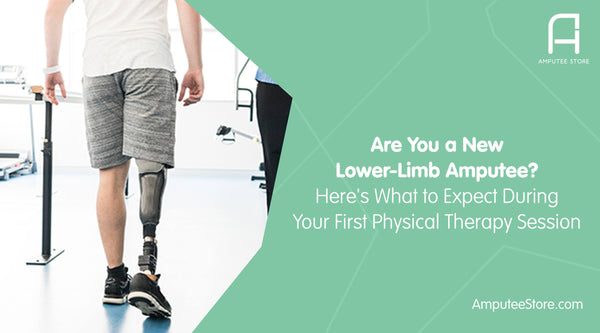Are You a New Lower-Limb Amputee? Here's What to Expect During Your First Physical Therapy Session
So, you’ve just been referred to physical therapy, and you’re not sure what to expect. We understand the apprehension that comes with experiencing therapy for the first time, so this article was created to discuss what to expect during your first few sessions.

Is there anything you need to do to prepare for your first appointment? Aside from wearing comfortably loose clothing and being your positive self, there’s nothing else you need to do to prepare.
Your physical therapist (PT) will ask you a lot of questions and spend a considerable amount of time evaluating your residual limb and, if available, your prosthesis. This is expected because your PT needs as much information as possible to treat your post-amputation condition and create a plan of care specifically for you.
Pain awareness
Managing postoperative pain will be a primary goal of your amputation rehabilitation team. To develop the best pain management plan for you, many of the questions your PT will ask will focus on pain. He/she needs to understand the type and severity of the discomfort you’re experiencing. Post-amputation, people typically experience three different types of pain:
1. Surgical discomfort
Amputation surgeries are complex. As with any surgery, there are many post-operative risks, so one of the first things your PT will do is review post-operative expectations and protocols with you. Your PT should discuss the type of discomfort that usually follows amputation surgery and explain what is considered normal discomfort.
2. Residual limb discomfort
The residual limb discomfort you experience postoperatively comes from the fact that your skin, muscle, and bone have been surgically altered. Some pain and discomfort are to be expected while you heal and your muscles move into their new positions and adjust to new movement patterns.
In addition to discussing residual limb pain, your PT will likely address neuromas, which could temporarily limit your rehabilitation potential. Your PT will also inspect the skin around your residual limb, document any observations such as leaking around the suture line, and review with you how to manage your suture line properly. This is a natural precursor to formulating an appropriate wound care management plan.
3. Phantom limb pain
During your amputation surgery, the surgeon only performed an amputation; he/she did not alter the sensory receptors in your brain. This is why many amputees experience phantom limb pain or phantom limb sensation.
Phantom limb sensation is when you feel as if all or part of your amputated limb is still there. Phantom limb sensation that is accompanied by pain is called phantom limb pain.
During your physical therapy sessions, your PT will aim to address phantom limb pain and discuss various pain management strategies with you. If you have not already purchased or been provided with a prosthetic shrinker, your PT may ask your orthopedic surgeon to order one for you.
Determining your functional level
A qualified member of your amputation rehabilitation team will identify your current and potential functional status using the K-Level classification system. There are five different K-Levels ranging from 0 to 5. Your K-Level is crucial because it communicates your functional potential to insurers, which in turn determines what type of prosthesis you’re eligible to receive.
Prosthetists and PTs typically use the Amputee Mobility Predictor, also known as the AMPPRO/AMPnoPRO method, to determine your K-Level. The Amputee Mobility Predictor is a functional outcome test comprised of 21 sections. It takes approximately 15 minutes to administer. The resulting score corresponds with an appropriate K-Level, which serves to quantify your need for and potential to benefit from a prosthesis.
Work with your prosthetic team
Ensuring the success of your post-amputation rehabilitation requires a team approach. If you decide to use a prosthesis, your prosthetist will be a key member of your rehabilitation team. The first time you meet with your prosthetist, he or she will typically measure you for a prosthetic shrinker (see Phantom Limb Pain above). Your prosthetist may also discuss the process of and timeline for receiving a prosthesis.
To help you achieve a successful outcome, your prosthetist should attend at least two of your physical therapy sessions. Ideally, your prosthetist should be present at your first physical therapy evaluation as well as your second gait training session. Gait training teaches you the proper movements for smooth and efficient walking. Your physical therapist will immediately begin gait training once you take delivery of your new prosthesis from your prosthetist. It’s helpful to have your prosthetist attend your second gait training session to make any necessary alignment or prosthetic length changes.
Summary
Your first physical therapy session will set the tone for your post-amputation rehabilitation. During this appointment, your PT will work to understand your unique needs, pain level, current functional status, and goals to develop a specific treatment plan for you. Your first few therapy sessions provide the opportunity for all of the members of your rehabilitation team to coordinate with one another and work together to lead you to the best possible post-amputation functional outcome.What was your first physical therapy session like? Please share your experiences with the community in the comments section below.










































































